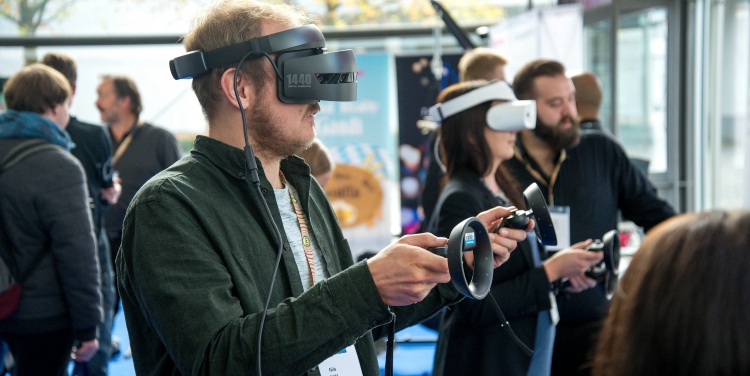The virtual reality (VR) industry is experiencing explosive growth, transforming the way people engage with entertainment, education, and business. With the global VR market projected to reach $339.29 billion by 2033, growing at a compound annual growth rate (CAGR) of over 27%, entrepreneurs have a unique opportunity to capitalize on this dynamic sector. This article explores key steps, opportunities, and trends for launching a successful VR business, with a focus on practical strategies and real-world examples like Anvio VR.
Understanding the VR Market
Before diving into the VR industry, thorough market research is essential. The VR landscape is diverse, spanning gaming, healthcare, education, and corporate training. Understanding local demand, target audiences, and competitors will help you identify gaps in the market. For instance, VR entertainment venues are gaining traction due to their ability to offer immersive, social experiences that appeal to families, gamers, and corporate groups. Trends like free-roam VR and multiplayer gaming are driving customer interest, making them ideal focal points for new ventures.
Key steps for market research include:
- Analyze Demand: Study local interest in VR experiences by surveying potential customers or analyzing foot traffic in entertainment hubs.
- Identify Competitors: Research existing VR arcades or franchises to understand their offerings and pricing.
- Define Your Audience: Determine whether you’ll target casual gamers, families, or businesses hosting team-building events.
The Entertainment Business: A Lucrative VR Niche
The entertainment business is one of the most promising areas for VR entrepreneurs. VR arcades and parks, such as those offered by Anvio VR, provide immersive experiences that traditional entertainment formats like go-karting or laser tag can’t match. Anvio VR, for example, specializes in free-roam VR arenas, allowing players to move naturally in expansive virtual worlds, enhancing immersion and replayability. These venues attract a broad audience, from young adventurers to corporate teams, and offer high profit margins with sessions priced at $20–$50 per person for 30–60 minutes.
To succeed in the VR entertainment business:
- Choose a Strategic Location: Opt for high-traffic areas like shopping malls or urban centers, requiring 200–400 square meters for setup.
- Leverage Franchising: Partnering with established brands like Anvio VR provides access to cutting-edge technology, game libraries, and marketing support, reducing startup risks.
- Focus on Customer Experience: Train staff to deliver exceptional service and create a welcoming environment to ensure repeat visits.
Capitalizing on VR Trends
Staying ahead of VR trends is critical for long-term success. Here are some key trends shaping the industry in 2025:
- Free-Roam VR: Unlike stationary setups, free-roam VR allows players to explore large virtual spaces, increasing engagement. Anvio VR’s multiplayer arenas exemplify this trend, offering games like Revolta that combine physical movement with immersive gameplay.
- Social and Multiplayer Experiences: VR is becoming a social activity, with group-based games and events driving customer retention. Venues that cater to birthday parties, corporate events, or team-building activities are seeing strong demand.
- Integration with AI and Metaverse: The convergence of VR with AI and the metaverse is creating new opportunities for personalized experiences and virtual worlds, appealing to tech-savvy consumers.
- Diverse Applications: Beyond entertainment, VR is expanding into education, healthcare, and retail, offering entrepreneurs opportunities to diversify revenue streams.
Building a Solid Business Plan
A comprehensive business plan is the foundation of any successful VR venture. Key components include:
- Financial Projections: Account for startup costs ($50,000–$200,000 for equipment, software, and space) and operational expenses like maintenance and staff training.
- Revenue Streams: Consider ticket sales, memberships, event hosting, and partnerships with local businesses.
- Marketing Strategy: Use social media, influencer partnerships, and viral content to promote your VR business. Anvio VR, for instance, provides franchisees with marketing resources and templates to attract customers.
A soft opening can help test operations and gather feedback before a grand launch, ensuring a smooth customer experience.
Overcoming Challenges
Launching a VR business comes with challenges that require careful planning:
- High Initial Costs: Equipment like VR headsets, PCs, and sensors can be expensive. Franchises like Anvio VR mitigate this with turnkey solutions and flexible financial models, such as pay-per-player systems.
- Technical Maintenance: Regular upkeep is essential to avoid downtime. Partnering with a franchisor that offers 24/7 technical support can streamline operations.
- Content Updates: Keeping games fresh is crucial for repeat customers. Anvio VR provides a regularly updated game library to maintain engagement.
- Competition: Differentiate your business with unique offerings, such as exclusive games or tailored experiences for specific audiences.
Marketing and Customer Engagement
Effective marketing is critical to attract and retain customers. Strategies include:
- Social Media Campaigns: Create shareable content showcasing your VR experiences to leverage the social nature of VR.
- Cross-Promotions: Partner with local businesses, such as restaurants or gyms, to drive foot traffic.
- Customer Feedback: Implement a feedback system to improve services and build loyalty. Anvio VR emphasizes high-quality customer service through training modules for franchisees.
Why Choose a Franchise Like Anvio VR?
Franchising offers a low-risk entry into the VR industry. Anvio VR stands out with its comprehensive support, including:
- Proven Business Model: Access to a market-tested framework that reduces trial-and-error.
- Technical Support: 24/7 assistance for software installation and equipment maintenance.
- Brand Recognition: Leverage Anvio’s global presence in cities like Moscow, San Diego, and São Paulo to attract customers.
- Exclusive Content: A library of nine unique games designed for diverse audiences, ensuring high replayability.
Anvio VR’s franchise model simplifies the startup process, allowing entrepreneurs to focus on operations and customer satisfaction.
Conclusion
Launching a successful VR business in 2025 requires strategic planning, market insight, and a focus on emerging trends like free-roam VR and multiplayer experiences. The entertainment business, exemplified by franchises like Anvio VR, offers a lucrative opportunity to deliver immersive experiences that captivate diverse audiences. By conducting thorough market research, crafting a solid business plan, and leveraging franchisor support, entrepreneurs can overcome challenges and build a thriving VR venture. As the industry continues to grow, now is the perfect time to turn your vision into a profitable reality.
David Prior
David Prior is the editor of Today News, responsible for the overall editorial strategy. He is an NCTJ-qualified journalist with over 20 years’ experience, and is also editor of the award-winning hyperlocal news title Altrincham Today. His LinkedIn profile is here.











































































